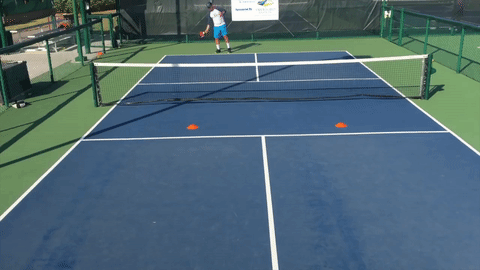Everything has a purpose...
 Yesterday post was my view of what an effective third shot should be. As you might guess from the title of this post, Mark Renneson also has a strong opinion on he topic. In this case, his is pretty closely aligned with mine. Below is an excerpt from his article It's Not What You Think: Myth-busting the Drop, which can be read in its entirety at the link.
Yesterday post was my view of what an effective third shot should be. As you might guess from the title of this post, Mark Renneson also has a strong opinion on he topic. In this case, his is pretty closely aligned with mine. Below is an excerpt from his article It's Not What You Think: Myth-busting the Drop, which can be read in its entirety at the link...when we are all together in the gym or on the court, everyone knows exactly what is meant by a third shot drop: a slow-moving reply to the return-of-serve. A shot that lands in or near the kitchen when the opponents are near the net. This is not big news. But then I ask them: “Why, exactly, would we hit this shot? What is the point of a drop?”. This is where things get interesting.
 |
| The 3rd Shot Drop is a response to a return of serve, used when opponents are at the NVZ. |
MYTH: THE DROP IS ABOUT MAKING YOUR OPPONENTS MOVE
Even if you choose to hit your drop near a sideline, it is such a slow shot that your opponents should have plenty of time to track it down and be on balance by the time they have to hit it back. While it might make them move a step or two, rarely will it move the receiver so much that they are off-balance when they hit.
MYTH: THE DROP IS ABOUT MAKING YOUR OPPONENTS MISS
We all love it when we hit a winning shot; when we hit a ball so challenging that our opponents are unable to return it in play. But this is not the goal of a drop. Unlike a third shot drive (a hard hit ball right at a net player), a drop is not designed to force an error. Remember, it is a slow moving shot right at the person! They have plenty of time to prepare and it is easy to make solid contact. I fully expect my opposition to get the ball back in play.
 |
| Developing the feel for the drop takes deliberate practice and patience. |
If I wanted to get to the net, I don’t need any special shot — I could just run forward. And if I wanted a little more time to move up, I could just lob the ball in the air and jog. That would get me to the net just fine, thank you very much.
By now you are likely thinking: “But that’s dumb, Mark! If you hit it high and run to the net, they’ll just smash it at you. You’ll be dead meat!”. You’re right, of course. And it is precisely here that the true purpose of the drop reveals itself. It is not about you, it’s about your opponents.
CAUSING TROUBLE VS. STAYING OUT OF TROUBLE
There is an important distinction I’d like to make. Sometimes we are on offense and try to make our opponents miss their shots by playing a difficult ball (e.g. hitting fast to take away their time; playing a great angle to make them run or reach; lobbing over their heads so they have to turn and chase, etc.). We could call this tactic “causing trouble”.
 |
| Aspen Kern makes Matt Wright pay the price for an ineffective drive: a fast ball down at the feet. |
Sometimes we find ourselves on defense. Our opponents have put us in a position (see the list above) where we are just struggling to get the ball back in play. We’ve got a problem. It may be an emergency. In this case, we are trying to “get out of trouble”.
But there is a third situation to consider. If I have served and my opponents play a standard return back to me at the baseline and rush to the net, I’m not really in trouble. I’m not desperate. But I’m also not in a position to really control the point. I’m at the back of my court with my opponents in a strong position up at the NVZ. I’m neither on offense or on defense. I’m in between. I’m in what we could call a neutral situation.
The value of the drop is in its ability to keep you in this neutral situation — to prevent you from sliding into defense. If I play a drive or a lob, I’m giving my opponents a high ball and I am at risk that they hit hard at me, putting me in a defensive situation. I don’t want that to happen. But if I hit a good drop that lands short enough and low enough that my opponents must make contact below net level, they have to hit upwards to get the ball back over. And if they are hitting upwards, they must also hit relatively slowly or else their shot is at risk of flying out...


No comments:
Post a Comment